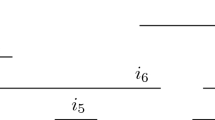Abstract
In this note, the problem of determining disjoint matchings in a set of intervals is investigated (two intervals can be matched if they are disjoint). Such problems find applications in schedules planning. First, we propose a new incremental algorithm to compute maximum disjoint matchings among intervals. We show that this algorithm runs in O(n) time if the intervals are given ordered in input. Additionally, a shorter algorithm is given for the case where the intervals are proper. Then, a NP-complete extension of this problem is considered: the perfect disjoint multidimensional matching problem among intervals. A sufficient condition is established for the existence of such a matching. The proof of this result yields a linear-time algorithm to compute it in this case. Besides, a greedy heuristic is shown to solve the problem in linear time for proper intervals.
The author works under contract with the firm Prologia-Groupe Air Liquide.
Access this chapter
Tax calculation will be finalised at checkout
Purchases are for personal use only
Preview
Unable to display preview. Download preview PDF.
Similar content being viewed by others
References
C. Berge (1985). Graphs. Elsevier Science Publishers B.V., Amsterdam, 2nd edition.
M.C. Golumbic (1980). Algorithmic Graph Theory and Perfect Graphs. Computer Science and Applied Mathematics. Academic Press, New-York.
P. Ramanan, J. Deogun, and C. Liu (1984). A personnel assignment problem. Journal of Algorithms 5, 132–144.
G. Steiner and J.S. Yeomans (1993). Level schedules for mixed-model, just-in-time processes. Management Science 39(6), 728–735.
J. Edmonds (1965). Maximum matching and a polyedron with 0,1 vertices. Journal of Research of N.B.S. B 69, 125–130.
S. Micali and V.V. Vazirani (1980). An \( O(\sqrt V E) \) algorithm for finding maximum matching in general graphs. In Proc. 21st Annual Symposium on Foundations of Computer Science, pages 17–27.
F.S. Roberts (1978). Graph Theory and its Applications to Problems of Society. SIAM, Philadelphia, PA.
M.G. Andrews and D.T. Lee (1992). An optimal algorithm for matching in interval graphs. manuscript.
M.G. Andrews, M.J. Atallah, D.Z. Chen, and D.T. Lee (2000). Parallel algorithms for maximum matching in complements of interval graphs and related problems. Algorithmica 26, 263–289.
J. Jàjà (1992). An Introduction to Parallel Algorithms. Addison-Wesley, Reading, MA.
M.R. Garey and J.S. Johnson (1979). Computer and Intractability: A Guide to NP-Completeness. W.H. Freeman.
H.L. Bodlaender and K. Jansen (1995). Restrictions of graph partition problems. Part I. Theoretical Computer Science 148, 93–109.
Bamboo-Planification by Prologia-Groupe Air Liquide. http://prologianet.univ-mrs.fr/bamboo/bamboo_planification.html
U.I. Gupta, D.T. Lee, and J.Y.-T. Leung (1982). Efficient algorithms for interval and circular-arc graphs. Networks 12, 459–467.
S. Olariu (1991). An optimal greedy heuristic to color interval graphs. Information Processing Letters 37, 21–25.
F. Glover (1967). Maximum matchings in a convex bipartite graph. Naval Research Logistics Quartely 4(3), 313–316.
W. Lipski, Jr. and F.P. Preparata (1981). Efficient algorithms for finding maximum matchings in convex bipartite graphs and related problems. Acta Informatica 15, 329–346.
G. Gallo (1984). An O(n log n) algorithm for the convex bipartite matching problem. Operation Research Letters 3(1), 31–34.
H.N. Gabow and R.E. Tarjan (1985). An linear-time algorithm for the special set union. Journal of Computer and System Sciences 30, 209–221.
G. Steiner and J.S. Yeomans (1996). A linear time algorithm for maximum matchings in convex, bipartite graphs. Computers and Mathematics with Applications 31(12), 91–96.
S.A. Cook and R.A. Reckhow (1973). Time bounded random access machines. Journal of Computer and System Sciences 7, 354–375.
M. Habib, R. McConnel, C. Paul, and L. Viennot (2000). Lex-BSF and partition refinement, with applications to transitive orientation, interval graph recognition and consecutive ones testing. Theoretical Computer Science 234, 59–84.
S.K. Kim (1989). Optimal parallel algorithms on sorted intervals. In Proc. 27th Annual Allerton Conference on Communication, Control and Computing, pages 766–775. Monticello, IL.
Author information
Authors and Affiliations
Editor information
Editors and Affiliations
Rights and permissions
Copyright information
© 2003 Springer-Verlag Berlin Heidelberg
About this paper
Cite this paper
Gardi, F. (2003). Efficient Algorithms for Disjoint Matchings among Intervals and Related Problems. In: Calude, C.S., Dinneen, M.J., Vajnovszki, V. (eds) Discrete Mathematics and Theoretical Computer Science. DMTCS 2003. Lecture Notes in Computer Science, vol 2731. Springer, Berlin, Heidelberg. https://doi.org/10.1007/3-540-45066-1_13
Download citation
DOI: https://doi.org/10.1007/3-540-45066-1_13
Published:
Publisher Name: Springer, Berlin, Heidelberg
Print ISBN: 978-3-540-40505-4
Online ISBN: 978-3-540-45066-5
eBook Packages: Springer Book Archive




